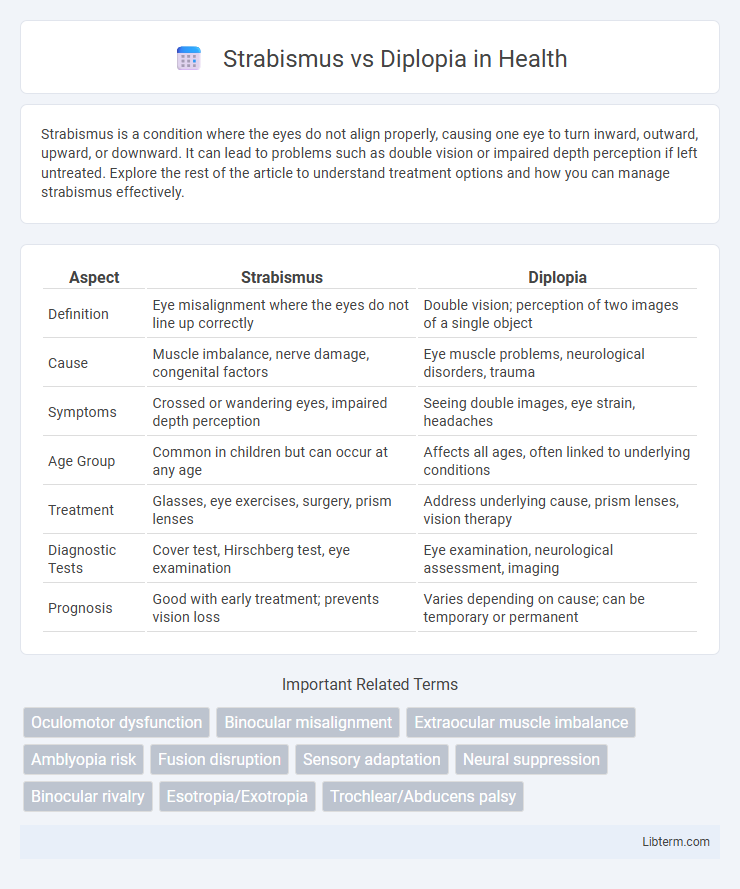Strabismus is a condition where the eyes do not align properly, causing one eye to turn inward, outward, upward, or downward. It can lead to problems such as double vision or impaired depth perception if left untreated. Explore the rest of the article to understand treatment options and how you can manage strabismus effectively.
Table of Comparison
| Aspect | Strabismus | Diplopia |
|---|---|---|
| Definition | Eye misalignment where the eyes do not line up correctly | Double vision; perception of two images of a single object |
| Cause | Muscle imbalance, nerve damage, congenital factors | Eye muscle problems, neurological disorders, trauma |
| Symptoms | Crossed or wandering eyes, impaired depth perception | Seeing double images, eye strain, headaches |
| Age Group | Common in children but can occur at any age | Affects all ages, often linked to underlying conditions |
| Treatment | Glasses, eye exercises, surgery, prism lenses | Address underlying cause, prism lenses, vision therapy |
| Diagnostic Tests | Cover test, Hirschberg test, eye examination | Eye examination, neurological assessment, imaging |
| Prognosis | Good with early treatment; prevents vision loss | Varies depending on cause; can be temporary or permanent |
Understanding Strabismus: Definition and Causes
Strabismus is a condition characterized by the misalignment of the eyes, where one eye may turn inward, outward, upward, or downward, disrupting binocular vision. It results from factors such as muscle weakness, neurological disorders, or congenital abnormalities affecting the eye muscles or their control centers. Understanding these causes is essential for accurate diagnosis and effective treatment to restore proper eye alignment and prevent associated complications like amblyopia.
What is Diplopia? An Overview
Diplopia, commonly known as double vision, occurs when a person sees two images of a single object, either horizontally, vertically, or diagonally displaced. It results from misalignment of the eyes or neurological issues affecting eye muscle coordination, and can be binocular--disappearing when one eye is closed--or monocular, persisting with one eye open. Unlike strabismus, which refers to the physical misalignment of the eyes, diplopia specifically describes the perceptual experience of seeing double.
Key Differences Between Strabismus and Diplopia
Strabismus is a condition characterized by the misalignment of the eyes, where one or both eyes deviate inward, outward, upward, or downward. Diplopia, or double vision, occurs when the brain receives two different images from the eyes, often caused by strabismus, neurological disorders, or trauma. The key difference lies in strabismus being a physical eye misalignment, whereas diplopia is a visual symptom resulting from various underlying causes, including strabismus.
Common Symptoms of Strabismus
Strabismus is characterized by the misalignment of the eyes, causing one eye to turn inward, outward, upward, or downward, which leads to symptoms such as double vision, eye strain, and difficulty focusing. Common symptoms of strabismus include amblyopia (lazy eye), headaches, and impaired depth perception due to inconsistent visual input. Diplopia, or double vision, often results from strabismus but primarily describes the perception of seeing two images of a single object.
Recognizing Signs of Diplopia
Diplopia, or double vision, manifests through symptoms such as seeing two overlapping images, eye strain, and difficulty focusing, which differentiates it from strabismus where eye misalignment is primary. Patients with diplopia often report worsening vision when tired or with specific gaze directions, highlighting the importance of recognizing these signs early for accurate diagnosis. Identifying diplopia involves assessing the presence of ghost images or double vision in both eyes, despite normal or corrected visual acuity.
Underlying Causes of Strabismus vs Diplopia
Strabismus primarily results from muscle imbalances or neurological disorders affecting eye alignment, such as cranial nerve palsies or congenital abnormalities. Diplopia originates from miscommunication between the eyes and brain, often linked to conditions like multiple sclerosis, trauma, or intracranial lesions impacting ocular motor function. Understanding the distinct underlying causes aids in accurate diagnosis and targeted treatment strategies for these visual disturbances.
Diagnostic Approaches for Strabismus and Diplopia
Diagnostic approaches for strabismus primarily involve the Hirschberg test, cover-uncover test, and prism cover test to assess ocular alignment and identify the deviation angle. Diplopia diagnosis relies on detailed patient history, extraocular muscle function tests, and neuroimaging when neurological causes are suspected. Objective assessments such as binocular vision tests and fusional amplitude measurements are essential for differentiating strabismus-induced diplopia from other causes.
Treatment Options: Strabismus Compared to Diplopia
Strabismus treatment options include glasses, eye patching, vision therapy, and surgical intervention to realign the eyes, aiming to improve binocular vision and prevent amblyopia. Diplopia treatments focus on addressing the underlying cause, such as nerve palsies or muscle restrictions, utilizing prism lenses, occlusion therapy, or strabismus surgery when misalignment is present. Unlike diplopia, which often requires symptomatic relief and cause-specific management, strabismus treatments emphasize correcting the ocular alignment to restore normal visual function.
Complications and Risks of Each Condition
Strabismus can lead to amblyopia, permanent vision loss in the weaker eye, and impaired depth perception due to misalignment of the eyes. Diplopia causes significant visual disturbance, increasing the risk of falls, accidents, and difficulty performing daily tasks because of double vision and impaired spatial awareness. Delayed treatment of either condition may result in chronic visual dysfunction and reduced quality of life.
Prevention and Long-Term Management Strategies
Strabismus prevention involves early detection through routine pediatric eye exams and corrective measures like glasses or vision therapy to promote proper eye alignment. Long-term management of strabismus may include surgical intervention to adjust eye muscles, combined with continuous monitoring to prevent recurrence and maintain binocular vision. Diplopia management focuses on identifying and addressing underlying causes, such as neurological conditions or refractive errors, with treatments ranging from prism glasses to vision therapy and, in some cases, surgical correction, emphasizing consistent follow-up to ensure symptom control and quality of life.
Strabismus Infographic

 libterm.com
libterm.com